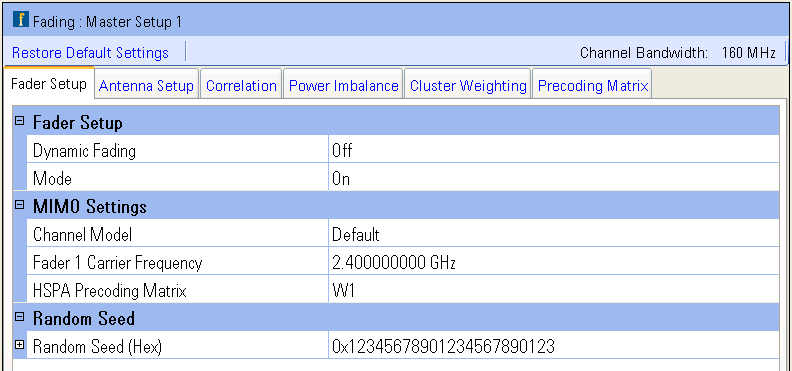
The three tabs as shown below access the Master Setup parameters for adding real-time fading to custom or Signal Studio generated waveforms. Additionally, clicking the Fader block in the block configuration or Fader Path node in the tree view displays the Fader Path parameters for the selected Fader Channel model.
Click a tab to display information for the related parameter settings.

Applying the Restore Default Settings in the Fader Setup view restores the default settings for the carrier frequency and the random seed and all Fader Paths to their default settings for the selected channel model.
Displays the channel bandwidth depending on the number of enabled paths.
Configurations with regular channels:
| Paths | Standard | R2C License (U01 or later) |
|---|---|---|
| 0-6 | 120 MHz | 160 MHz |
| 7-12 | 80 MHz | 80 MHz |
| 13-24 | 40 MHz | 40 MHz |
Configurations with split channels that require split fading Option N5106A-169 (e.g., 2x8 MIMO and 4x4 MIMO):
| Paths | Standard | R2C License (U01 or later) |
|---|---|---|
| 0-6 | 60 MHz | 80 MHz |
| 7-12 | 40 MHz | 40 MHz |
| 13-24 | 20 MHz | 20 MHz |
You can configure the fading channel parameters in one of several ways:
select a standard model for the fader that will automatically populate the path configurations, antenna setups, and calculate the correlation as specified in the standards for the selected model
select a standard model and customize path configurations, antenna setups and/or correlation coefficients
select no standard model and customize all conditions for your DUT operation and environment
enter user-defined path data to more closely simulate the real-world environment of your DUT
|
gives information on setting general fading parameters, available standard channel models and associated profiles. |
|
|
details the antenna type, polarization, and orientation to be used for the transmit/receive antennas. |
|
|
displays the correlation coefficients according to the current channel configuration. |
|
| Power Imbalance | describes the features of the Power Imbalance tab. |
| Cluster Weighting | describes the Cluster Weighting tab, which replaces the Power Imbalance tab when using a multiprobe MIMO OTA channel model (e.g., Ring of Probes Method). |
|
defines the available parameters for the fading paths. |